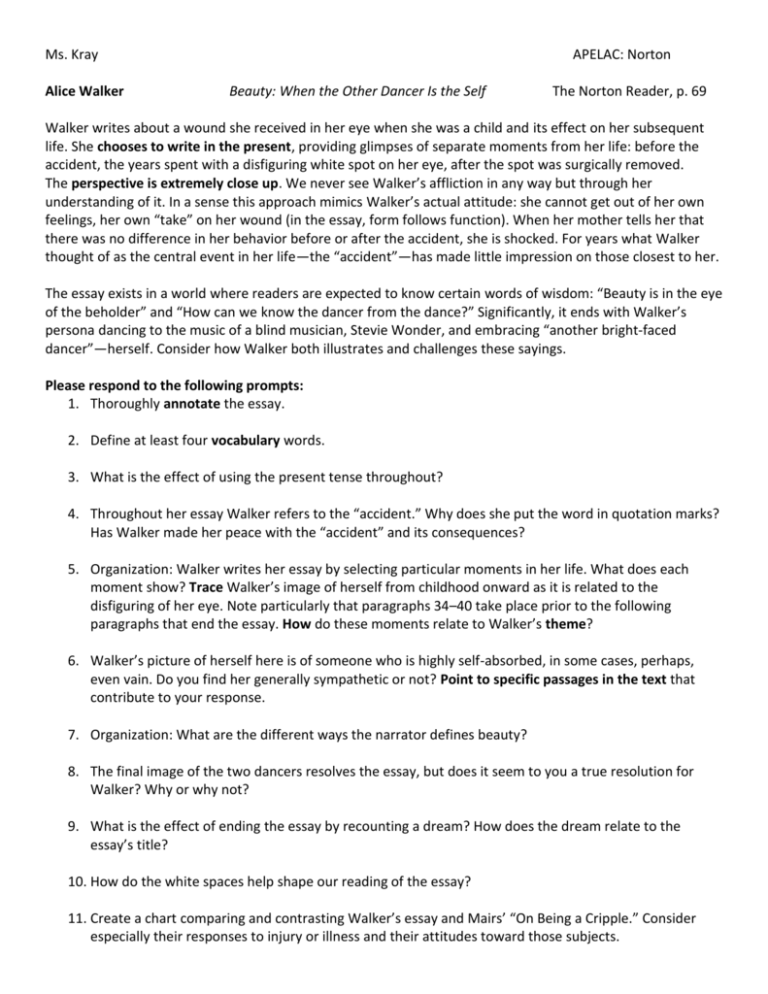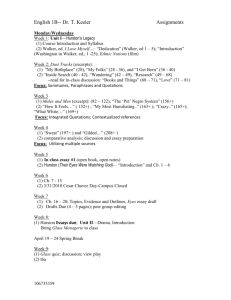Walker Beauty SQ Norton plus.doc
advertisement

Ms. Kray Alice Walker APELAC: Norton Beauty: When the Other Dancer Is the Self The Norton Reader, p. 69 Walker writes about a wound she received in her eye when she was a child and its effect on her subsequent life. She chooses to write in the present, providing glimpses of separate moments from her life: before the accident, the years spent with a disfiguring white spot on her eye, after the spot was surgically removed. The perspective is extremely close up. We never see Walker’s affliction in any way but through her understanding of it. In a sense this approach mimics Walker’s actual attitude: she cannot get out of her own feelings, her own “take” on her wound (in the essay, form follows function). When her mother tells her that there was no difference in her behavior before or after the accident, she is shocked. For years what Walker thought of as the central event in her life—the “accident”—has made little impression on those closest to her. The essay exists in a world where readers are expected to know certain words of wisdom: “Beauty is in the eye of the beholder” and “How can we know the dancer from the dance?” Significantly, it ends with Walker’s persona dancing to the music of a blind musician, Stevie Wonder, and embracing “another bright-faced dancer”—herself. Consider how Walker both illustrates and challenges these sayings. Please respond to the following prompts: 1. Thoroughly annotate the essay. 2. Define at least four vocabulary words. 3. What is the effect of using the present tense throughout? 4. Throughout her essay Walker refers to the “accident.” Why does she put the word in quotation marks? Has Walker made her peace with the “accident” and its consequences? 5. Organization: Walker writes her essay by selecting particular moments in her life. What does each moment show? Trace Walker’s image of herself from childhood onward as it is related to the disfiguring of her eye. Note particularly that paragraphs 34–40 take place prior to the following paragraphs that end the essay. How do these moments relate to Walker’s theme? 6. Walker’s picture of herself here is of someone who is highly self-absorbed, in some cases, perhaps, even vain. Do you find her generally sympathetic or not? Point to specific passages in the text that contribute to your response. 7. Organization: What are the different ways the narrator defines beauty? 8. The final image of the two dancers resolves the essay, but does it seem to you a true resolution for Walker? Why or why not? 9. What is the effect of ending the essay by recounting a dream? How does the dream relate to the essay’s title? 10. How do the white spaces help shape our reading of the essay? 11. Create a chart comparing and contrasting Walker’s essay and Mairs’ “On Being a Cripple.” Consider especially their responses to injury or illness and their attitudes toward those subjects. Suggestions for further thought: This essay is about Walker “making peace” with the accident. To what extent is it also about making peace with other things? Is the accident some kind of metaphor, or by calling it one, do we diminish the impact it had on her life? Suggested Enrichment Writing Assignments 1. Take an event that helped shape your life, a “defining moment,” and tell about it and its influence as a series of moments narrated in the present tense. 2. Read Annie Dillard’s “Sight into Insight” (NR p. 1190) in connection with Walker’s essay, and then write an essay of your own that addresses the way these two writers use different meanings of the word “see.” You’ll probably find yourself expanding on their notions, explaining what they’re getting at, or agreeing or disagreeing with them.








